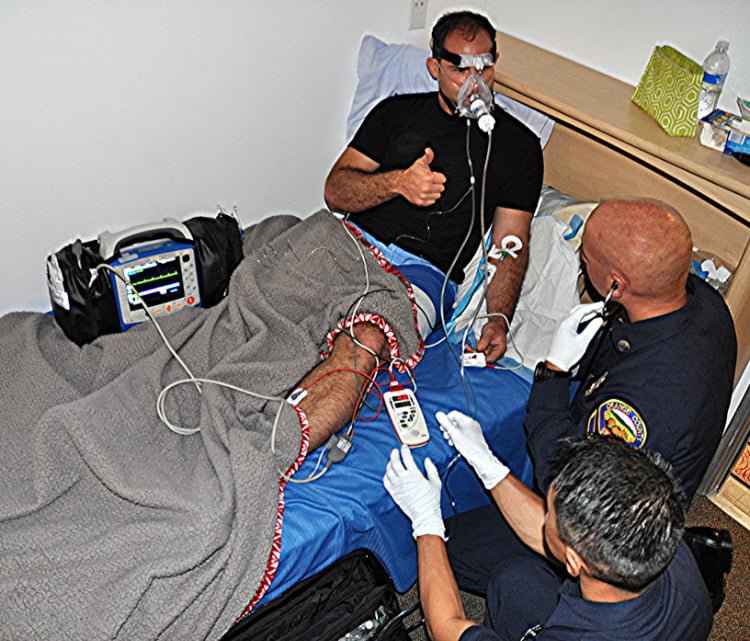
Photo by Rick McClure
A reasonable CPAP trial should last no more than 20 minutes.
Once you’ve decided to use CPAP, and convinced your patient to cooperate (see Successfully Selling CPAP), you’ll need to monitor the effectiveness of CPAP. It may be necessary to adjust your CPAP pressure, resolve significant mask leaks, reassure your patient or progress to assisted ventilation when CPAP fails. This article will review the tools you have available to help you make the best patient care decisions when using CPAP.
The indication for use of CPAP can affect how quickly you should expect to see improvement. Patients with acute pulmonary edema respond immediately to CPAP1, often showing significant improvement within 1-2 minutes. Patients with respiratory issues, such as COPD exacerbations or pneumonia, can take much longer to respond, often on the order of 10-15 minutes. Clinical guidelines for use of CPAP recommend a trial of 20 minutes2 during which time, a failure to improve suggests moving on to another form of respiratory support.
The best feedback on CPAP effectiveness is most likely your patient. Similar to pain scores, modified Borg scales have frequently been described in medical literature as a rapid and effective ways of conveying a patient’s subjective state of dyspnea.3 A scale of zero to ten – where zero is no breathlessness and ten a maximal difficulty breathing – can readily be provided by patients, even when their shortness of breath limits the ability to speak. Once CPAP has been applied, a patient’s numerical reassessment of their dyspnea can help assess effectiveness.
Comparative assessment findings, which require clinical judgement, also help you determine the effectiveness of CPAP. These include: intercostal retractions, nasal flaring, pursed lip breathing and patient posturing. Patients who previously had to sit bolt upright, perhaps leaning on their elbows for chest wall support, and are able to relax and sit back on the stretcher once CPAP is applied, are likely benefiting from your treatment. Lessening (or worsening) of other signs also provides valuable clues.
Level of consciousness is also important. Acutely dyspneic patients are often very restless and sometimes overtly agitated. When you can’t breathe, nothing else matters. Successfully treating dyspnea with CPAP can reduce agitation and allow the patient to relax. It is however important not to be fooled by a declining level of consciousness. Patients with difficulty breathing who become somnolent, or otherwise obtunded, have likely progressed to respiratory failure. High levels of retained CO2 are narcotizing and depress wakefulness. A patient who is not easily aroused should be presumed to be deteriorating, not simply relaxed and comfortable.
Oxygen saturation can be a useful tool for assessing respiratory distress, but typically only without administration of supplemental oxygen. The majority of prehospital CPAP units are driven by oxygen. While their effective FiO2 is low, they significantly decrease the value of pulse oximetry as a tool for monitoring respiratory distress. Nonetheless, if oxygen saturations demonstrate a significant upward or downward trend during use of CPAP, they do provide some indication of patient improvement or decline.
End tidal CO2 is also a helpful tool for assessing the effectiveness of CPAP. In order to get reliable readings, it is necessary to use a nasal-cannula type capnography device with an oral pillow. This avoids carbon dioxide wash-out from the high gas flows seen in CPAP units. In patients without COPD, an EtCO2 greater than 70 mmHg is a clinical indicator of respiratory failure, suggesting the need for assisted ventilations. Watching the EtCO2 trend following CPAP application can not only help with titrating CPAP pressures, but provide feedback on effectiveness. The target should be an EtCO2 in a normal range of 34 to 45 mmHg. Keep in mind that it might take an hour or two to achieve this goal, so, for prehospital purposes, trending in the right direction is more important than the EtCO2 value.
Combined, the tools described here should help you to assess the effectiveness of CPAP. No one parameter will suffice by itself. In the end, your clinical judgement on how you believe your patient is responding can be just as valuable as your assessment findings. Unfortunately, hospital studies have shown that clinician ability to predict patients with high likelihood of success with CPAP is poor.4-5 There is little reason to believe that EMS clinicians perform any better. Additionally, the failure rate of CPAP is high, with up to one-third of patients requiring more aggressive management.6
Knowing what to look for when assessing the effectiveness of CPAP will help you to adjust your care and, when necessary, move on to more aggressive management such as assisting ventilations. A reasonable CPAP trial should last no more than 20 minutes. In that relatively short time, you need to make a decision as to whether your patient is improving or worsening.
References
- Vital FM, Ladeira MT, Atallah AN. Non-invasive positive pressure ventilation (CPAP or bilevel NPPV) for cardiogenic pulmonary oedema. Cochrane Database Syst Rev 2013.
- Rochwerg B, Brochard L, Elliott MW, et al. Official ERS/ATS clinical practice guidelines: noninvasive ventilation for acute respiratory failure. Eur Respir J. 2017; 50.
- Burdon JGW, Juniper EF Killian KJ, Hargrave FE, Campbell EJM. The perception of breathlessness in asthma. Am Rev Respir Dis 1982; 126:825-8.
- Antón A, Güell R, Gómez J, et al. Predicting the result of noninvasive ventilation in severe acute exacerbations of patients with chronic airflow limitation. Chest 2000; 117:828.
- Karnik AM. Noninvasive positive pressure ventilation: testing the bridge. Chest 2000; 117:625.
- Antonelli M, Conti G, Moro ML, et al. Predictors of failure of noninvasive positive pressure ventilation in patients with acute hypoxemic respiratory failure: a multi-center study. Intensive Care Med 2001; 27:1718.
Mike McEvoy, PhD, NRP, RN, CCRN, is the EMS coordinator for Saratoga County, New York, and the professional development coordinator for Clifton Park and Halfmoon Ambulance. He is a nurse clinician in the adult and pediatric cardiac surgery intensive care units at Albany Medical Center, where he also teaches critical care medicine. McEvoy is the chief medical officer and firefighter/paramedic for West Crescent Fire Department in Clifton, New York. He is also the chair of the EMS Section board of directors for the International Association of Fire Chiefs and a member of the New York State Governor’s EMS Advisory Council. He is a lead author of the textbook Critical Care Transport, the “Informed” Pocket References (Jones & Bartlett), and the American Academy of Pediatrics textbook Pediatric Education for Prehospital Professionals (PEPP).


